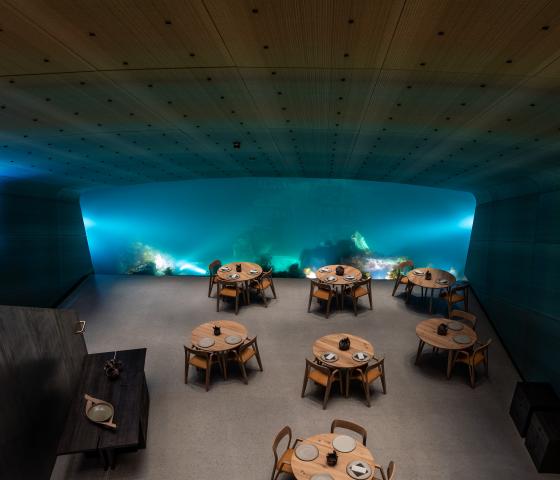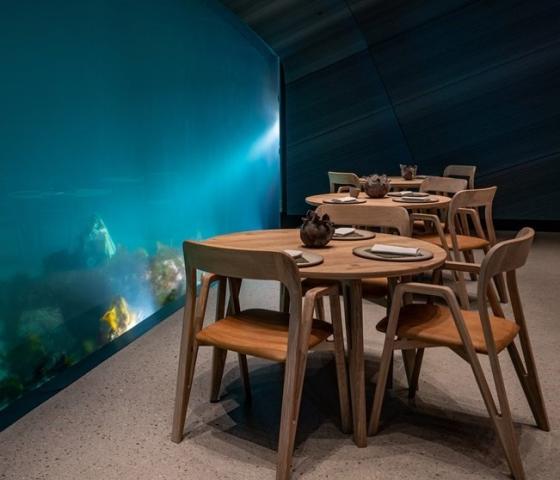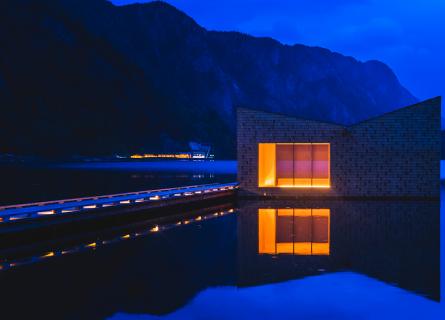
When food meets marine biology
Light affects life underwater.
Europe’s first underwater restaurant uses light to promote marine biodiversity – while teaching visitors about marine life.
The large cement block appears to sink to the bottom of the ocean where it rests against the Lindesnes rocks, halfway into the North Atlantic (see cover photo). The construction blends in with the surroundings as the surroundings and merges with the rugged nature. As Europe’s first underwater restaurant and marine biology research centre, Under is a tribute to the wild coastal landscape of Norway’s southern tip.
”We want to create a unique gastronomic experience that changes the way visitors perceive the ocean”, says Stig Ubostad, owner and project manager for the restaurant.
Five metres below the surface, visitors can enjoy fine dining and mesmerizing views of marine life. However, Under is not an aquarium. The building will eventually become part of the marine environment and home for marine species. The rough concrete surface is designed to attract mussels which will transform the restaurant into an artificial reef that helps cleaning the ocean and attract other species. The goal is to increase biodiversity. The restaurant will also serve as a research centre for marine life.

Light can attract fish
Working closely with world renown architects Snøhetta, ÅF Lighting have developed a lighting design that extends beyond the interiors and into the water, visually connecting the interiors with the ocean outside. It is all about creating an experience – how the lighting is designed, controlled and tuned is intrinsic to the success of the restaurant. Research shows that light has a significant impact on the ocean’s ecosystems. Because people often live near costlines and along waterways, these areas are particularly exposed to artificial light. However, all lighting does not have the same effect. How fish react depends on the amount of light and its spectral distribution. With the help of marine biologists, ÅF researched how artificial lighting can be designed to have a positive impact on the marine environment.
”Marine species are affected differently, depending on the type of light source – for example, whether it has a high content of red or blue light – and by the amount of light. We want to use artificial lighting only when neccessary. The building is designed to use sunlight and skylight to the greatest extent possible”, says Morten Jensen who leads the team of lighting designers at ÅF Lighting, part of AFRY.
Liquid light – a floating light solution
Even in the restaurant, lighting has a central focus. The lighting should give visitors a feeling of being part of the marine environment. The guests should be able to see as much of the ocean as possible without the space becoming what Morten calls a ”Disney light show”. Every lighting detail is fine tuned to the surrounding environment. For instance, the way light renders the sea and the interior, and how the food looks on the plate when presented in the restaurants light. ÅF Lighting are pioneering its new and unique lighting concept for the project – Liquid Light.
”Liquid Light is a new concept that we have developed ourselves where light flows through the room and pools where it is needed. We use LED lights in a matrix located in the ceiling. The light sources are small and have great glare control, making them almost invisible to people in the space. Technically, Liquid Light consists of several different technical solutions. What is unique, is how they are combined. For example, the infrared sensors detect heat while acoustic detectors respond to sound frequencies in the room. The collected data is interpreted and transformed into light that is dynamically changing and constantly adapting to the people using the space. It is a concept that saves energy, and we can harmonise the indoor lighting with nature and the seasons outside”, explains Morten Jensen.
It is about psychology
The water surrounding the restaurant is cold and dark, and the sea can be perceived as scary. To maintain the natural light and create a safe atmosphere at the bottom of the ocean is one of the most challenging tasks of the project.
”Lighting is always about highlighting the architecture in the right way, but this time, it is also about psychology. How can we help people feel secure when they are sitting below sea level? We have collected many insights from similar projects where there is very little daylight, like tunnels for example. The experience and challenges are similar to Under”, says Morten.
One of the owners, Stig Ubostad, hopes that a restaurant visit will be a holostic experience that increases interest in marine life and how we use the resources of the sea.
”Few know what is in Norwegian waters, and it is dark and colourless. But life underwater follows the seasons on land and visitors will notice this. The food will follow these shiftings. By what is served on the plate, we want to spread knowledge about marine life.”



